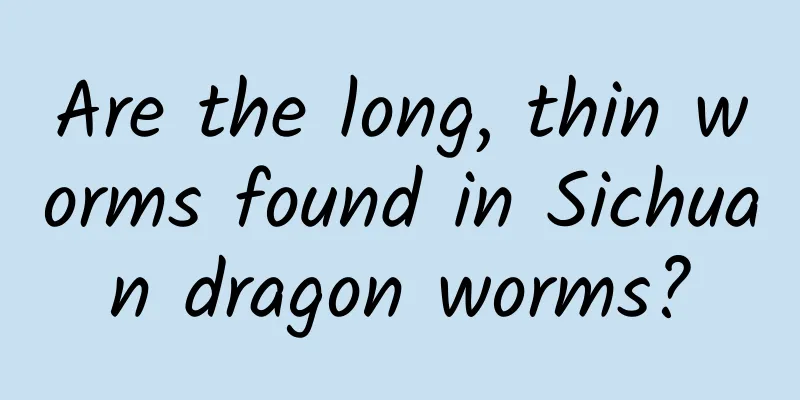Afraid of allergies and afraid to appreciate flowers? These "invisible" flowers are the culprit!

|
The peak season for pollen allergies is here again. Although not fatal, pollen allergies can still make people shed tears, have runny noses, and itchy throats, which is particularly annoying. What's even more strange is that some people who were not allergic to pollen have also been infected without knowing it. Outdoor "killers" in spring Pollen is the structure of plants that spread sperm. Some plants rely on animals to spread pollen, that is, insect-pollinated flowers and bird-pollinated flowers. The pollen of these plants does not spread over a large area and is unlikely to cause allergies. Some plants (wind-pollinated flowers) rely on wind for pollination. The pollen is large in number, small and light. When a strong wind blows, the pollen is carried in all directions. The pollen of these plants is the main cause of allergies. Drinking nectar and taking pollen with you, it really is a "full load" | Lennart Tange / Flickr Because different regions have different vegetation types and plant species, the culprits of pollen allergies also vary greatly from region to region. However, there are a few types of plants that are more responsible and have caused allergies in countless people across the country. The main source of allergenic pollen in spring is trees , including paper mulberry, elm, sycamore, and various pines, cypresses and willows. Mulberry (Morus alba) and paper mulberry (Broussonetia papyrifera) are both members of the Moraceae family. When ripe, they produce coveted fruits, which hang from branches like red lanterns. Their fruits are so bright, but their flowers are extremely plain, because as wind-pollinated flowers, Moraceae plants do not need to have colorful petals to attract insect pollination. Fruit and male inflorescence of paper mulberry | Zeynel Cebeci (left) Didier Descouens (right) / Wikimedia Commons Poplars and willows grow fast, can form shade within a few years, and are drought-resistant and resistant, so they have become the main force of street trees in North China. But the consequence is that every spring and summer, the whole city is filled with poplar and willow catkins. The harm of Salicaceae is not only in the flying catkins. Since they bloom, the pollen of male plants has begun to challenge our immune system. The flying catkins come from female plants. They are not as allergenic as pollen, but the flying catkins have a stronger presence, so they are often blamed for the real allergen pollen. As we all know, early summer in the north is made of cotton | Tyler Woo / flickr The pollen concentration of Sabina chinensis is usually higher than that of Salicaceae, especially in the "imperial capital" Beijing. "Historical Records" says: "Pine and cypress are the best of all trees." Cypress has been a very virtuous tree since ancient times . Various royal gardens, temples, and government agencies in Beijing love juniper, and even the surrounding mountains are planted with large tracts of cypress. The leaves of juniper usually have two forms, thorny leaves and scale leaves. When the flowering period comes, microspore cones (also known as male cones, but not real flowers) will grow at the end of the scale leaves, and pollen will be stored in them. Once the wind blows, the male plants of juniper will float yellow smoke, and annoying allergy symptoms will follow. The spiny and scale leaves of a juniper, with the male cones of the juniper visible at the end of the scale leaves | Wikimedia Commons Cryptomeria japonica, also a pine tree , is the main culprit for allergies in Japan every year. In the popular TV series "Cells at Work!", one of the allergens is the pollen of Cryptomeria japonica. The unique appearance of cedar pollen | Cells at Work! In early spring, the amount of pollen from Japanese cedar is particularly large. When it is dispersed together, it can gather into a light yellow pollen cloud that can travel hundreds of kilometers with the wind. Tokyo's pollen cloud | tokyo-eiken.go.jp Although Japanese cedar is endemic to Japan, it did not cause such a large-scale allergy in the past. The turning point occurred around 1960, when the Japanese government carried out large-scale afforestation , planting Japanese cedar. At the same time, due to urbanization , many lands and grasslands were replaced by concrete floors, which weakened the ability to absorb pollen. As a result, pollen allergy became a national disease in Japan . In reality, Japanese cedar pollen looks like this under an electron microscope | Bill Hearl / Flickr Summer and autumn are not idle either The trees that cause allergies in spring are mostly planted for greening purposes and can be controlled through urban planning. However, the allergens in summer and autumn are more difficult to deal with because most of them come from herbaceous plants and are difficult to control. In my country, the most common allergenic pollens in summer and autumn come from the Poaceae, Amaranthaceae, Asteraceae and Cannabaceae families, most of which are the groups that botanists would like to step on in the wild. Poaceae is a large category that includes food crops like rice, wheat, sorghum, and corn, as well as common weeds like foxtail grass and crabgrass. Weeds are distributed in various environments and can be said to be unavoidable. Of course, foxtail grass is more of a toy for most people | pxhere Among the Amaranthaceae plants, the species of the Chenopodium subfamily are often the cause of allergies. Many plants of the Chenopodium subfamily are also common weeds, such as Chenopodium album, C. ficifolium, C. glaucum, C. hybridum, etc., which are collectively called "gray-gray vegetables" in China. Their fruits are utricles, with dry skin like a film, and their seeds are easily spread by the wind. They have strong vitality, and even if the plant body on the ground is removed, the seeds in the soil will germinate in a few days to form a large area. Quinoa, commonly known as "gray-gray vegetable" | Hugo.arg / wikimedia Inflorescence of Chenopodium | Desert Porcupine Artemisia in the Asteraceae family is also a common allergenic group with many species. Most of these plants have fine and deep cracks on their leaves, which have a strong fragrance (or odor) when crushed. They have a lot of pollen and seeds, which are blown everywhere by the wind and can grow taller than a person if you are not careful. There is a saying that " there is no Artemisia on the ancestral grave ", which originally means to mock bad luck, but also indirectly shows that everyone assumes that Artemisia is the most common plant in the wilderness. Artemisia absinthium, the wormwood used to make absinthe | AfroBrazilian / wikimedia The three-lobed ragweed (Ambrosia trifida) and the humulus japonicus (Humulus japonicus) are particularly criticized . The three-lobed ragweed is also a member of the Asteraceae family. It is native to North America and later invaded the world. It is listed in the "List of Invasive Alien Species in China" and is an invasive plant that is the focus of national prevention and control . In its place of origin, the three-lobed ragweed causes allergies in 5% to 15% of people every year and is a major allergen. Three-leaved ragweed | sbs.utexas.edu Humulus belongs to the Cannabaceae family and is a relative of hops. It is distributed throughout the country. Its leaves are deeply lobed and its vines are covered with barbs. It is commonly known as Lala vine . Humulus grows very fast. Because it is a vine, it can spread in all directions, so it can cover a large area in just a few days. It begins to spread pollen in summer and autumn. Humulus, note the thorns on the vine | Dalgial / wikimedia Allergies In fact, allergies have a more formal name in medicine - allergy (not what you think). If you go to the hospital for an allergy, you need to make an appointment with the allergy department. Allergies can be divided into four types (Ⅰ-Ⅳ). Pollen and food allergies belong to type Ⅰ allergy, which comes and goes quickly. It is actually a misunderstanding of the immune system at work. When foreign macromolecules invade the human body, they trigger the immune system to eliminate these invaders. These macromolecules that can activate the immune system are called antigens . Antigens are present on the surface of bacteria, viruses, parasites and other pathogens. When antigens enter the human body, they will cause a complex immune response, one of which is to make plasma cells produce and release antibodies . Antibodies, also called immunoglobulins, can recognize and bind to antigens carried by invaders, interfere with their physiological activities, and help immune cells eliminate them faster. Plasma cells are specialized B lymphocytes | Cells at Work! Plasma cells under a light microscope. The nucleus is round and leaning towards the cytoplasm. The red round and lightly stained center is the red blood cell. | wikimedia The antibodies produced by plasma cells can be roughly divided into five categories: IgA, IgD, IgE, IgG and IgM, which are suitable for different occasions. The one we have heard the most about is probably IgG, which has a long lifespan and small molecules. It is the only one of the five types of antibodies that can cross the placental barrier and can be passed from mother to fetus. The main active ingredient in the anti-venom serum for rabies and snake venom is also IgG. Among the five types of antibodies, IgE is the one that is related to allergies . In fact, it is originally used to fight parasites. When parasites invade, plasma cells will release a lot of IgE, and IgE will combine with mast cells. Mast cells are a type of immune cell with a particularly long lifespan. They contain a large amount of active mediators such as histamine . Just like a grenade, it does not explode normally, but only explodes when the string is pulled. IgE is responsible for pulling the string. When mast cells combine with IgE, they will release internal substances such as histamine to eliminate parasites. Mast cells have nothing to do with hypertrophy | Cells at Work! Under staining conditions, a large number of blue-purple basophilic granules can be seen in the cytoplasm of mast cells. Vasoactive substances such as histamine are in these granules. The nearly round nucleus in the middle of the cell | Dean D. Metcalfe / Blood (2008) The direct cause of allergic symptoms is histamine. Under normal circumstances, histamine is released in large quantities only when parasites invade. However, for unknown reasons, some people's immune systems treat some substances that are not parasites as parasites . When exposed to these substances, a large amount of IgE is produced, which "detonates" mast cells, releases histamine, and causes allergies. These substances that are mistaken for parasites are allergens. When the body first encounters an allergen, IgE only binds to mast cells and does not "explode"; when it encounters the same allergen again, it will "explode" in large quantities. Therefore , allergic reactions generally occur after a person comes into contact with an allergen for the second time , and such a history of contact is also very important for doctors to diagnose. In Cells at Work!, histamine is depicted as a spray device. In short, it requires certain conditions to be triggered | Cells at Work! If you want to get rid of allergies, avoiding contact with allergens is the most effective way. Pollen from various herbs is difficult to control from the source. The best anti-allergy measure is to stay away from allergens as much as possible, such as turning on the air purifier in the room, wearing a mask when going out, etc. In serious cases, take medicine in time. Of course, different anti-allergic drugs have different mechanisms of action, and the allergies and adverse reactions they target may also be different. Everyone must follow the doctor's instructions and never take them indiscriminately. Author: Desert Porcupine Title image source: peakpx This article comes from GuokrNature (ID: GuokrNature) If you need to reprint, please contact [email protected] Welcome to forward to your circle of friends |
>>: In the screen age, how to minimize the impact of electronic screens on children?
Recommend
The recurrent laryngeal nerve that “takes a detour”, is this irrefutable evidence from fish to humans?
Many friends have heard that thyroid surgery can ...
A well-known singer fainted due to heat stroke shock. Learn this guide to dealing with heat stroke!
It was reported that singer Eason Chan fainted du...
Rare! New discovery in Hoh Xil
Hoh Xil, located on the Qinghai-Tibet Plateau, is...
An asteroid may hit the Earth in 7 years? Don't be afraid, it's not the first time...
Editor: Dong Xiaoxian Reviewer: Zhang Chao, Li Pe...
What is carrageenan and what role does it play in ice cream?
Recently, "ice cream assassin" has beco...
The promotion has no effect and there are malicious clicks. How to solve it?
Recently I heard a lot of people talking about pr...
Waymo's wholly-owned subsidiary for driverless cars settles in China, shares office space with Google in Shanghai
Waymo's Chinese subsidiary is named Huimo Bus...
Valuation Modeling Skills Enhancement Course 5
Whether it is a written interview or an internshi...
Zhihu, Toutiao, NetEase Cloud Music, 21 marketing details that still have dividends
As WeChat and Weibo operations become increasingl...
Online Bootcamp Operation Manual (SOP)
As we all know, training camps have become the mo...
What should you do if you have spring allergies and tears?
Since March, the number of patients suffering fro...
AR and VR: The inevitable limitations of alternative realities
Despite significant advances, augmented reality (...
Still giving birth at 74! You definitely don’t know the secrets of these birds
At the end of 2024, a black-backed albatross name...
How to operate an APP software online?
In general, app operations are divided into two a...
Google launches black technology again: can help goddesses remove mosaics
There is nothing more annoying than having your p...









